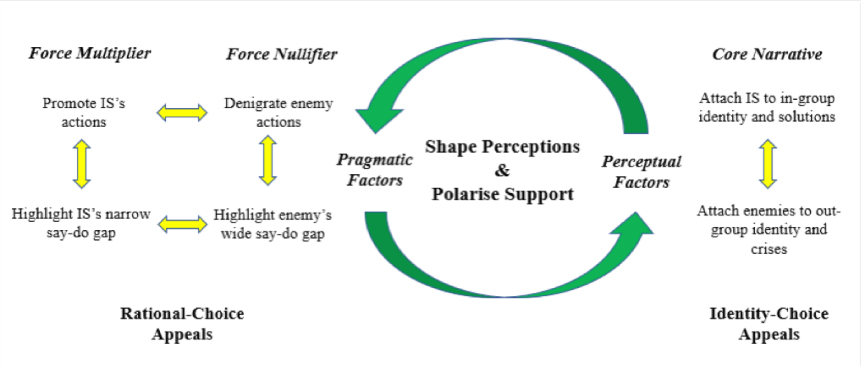By Haroro J. Ingram & Alastair Reed
The challenges associated with confronting militant Islamist propaganda have not waned with the territorial demise of the so-called Islamic State (ISIS). Sure, ISIS’s propaganda output is down overall from the peaks of 2015 and this downward trend has provided the backdrop for periods of particularly sharp declines in mid-2016 and late-2017. Yet these lulls have been followed by bounces in production or seemingly strategic pivots in the information theatre. More broadly, ISIS has demonstrated to other militant Islamists – whether friends or foes – the extraordinary potential of propaganda as a tactical, operational and strategic tool.
Given both the resilience of ISIS’s propaganda apparatus and its influence on other groups, understanding its propaganda strategy and devising ways to undermine its strengths and exploit its weaknesses will be essential to improving CT-CVE strategic communications theory and practice. This approach has driven much of the Counter-Terrorism Strategic Communication (CTSC) Project’s work which has examined the issue of how best to confront violent extremist propaganda from a range of historical, organizational, content and operational perspectives. The CTSC Project’s latest publication, titled “Islamic State’s English-language magazines, 2014-17: Trends & implications for CT-CVE strategic communications”, identifies key trends in the narratives, themes and propaganda strategies deployed in ISIS English-language magazines and draws out their implications for CT-CVE practitioners. In this two part series were examine three of these trends and the lessons for strategic communication counterstrategies.
Opportunities & Limitations
The collection of primary source materials that informs this study spans almost three and a half years, four magazines and thirty-five issues: Islamic State News (issues 1-3), Islamic State Report (issues 1-4), Dabiq (issues 1-15) and Rumiyah (issues 1-13). It is a collection that offers important insights into an array of propaganda levers and strategies used by ISIS, reveals patterns in how its messaging is deployed during periods of boom versus bust as well as provides insights into the narratives of crisis and solution that its propagandists believe will resonate amongst target audiences. There is much that scholars and practitioners can learn from exploring these trends. However, it is important to first make clear the limitations of the primary source materials that were used in this study.
In recent years the research field has been flooded with studies of ISIS’s online English-language propaganda, especially analyses of its magazine Dabiq. For Western scholars, such content is easily obtained online and linguistically accessible. Yet the risk for researchers and practitioners is that a disproportionate focus on ISIS’s English-language messaging, much like the field’s often myopic attention to its online propaganda, creates an availability bias that can misguide scholarly understanding and strategic-policy responses. It is false to assume that ISIS’s English-language content is representative of its overall propaganda strategy and messaging output. However, placed in its appropriate context, analyzing ISIS’s English-language messaging can be tremendously useful for both scholars seeking to understand the nuances of the group’s strategy and practitioners charged with combating its appeal.
Three trends & their implications for CT-CVE practitioners
“Islamic State’s English-language magazines, 2014-17: Trends & implications for CT-CVE strategic communications” sought to provide the fields of research and practice with a reference guide to ISIS’s English-language magazines rather than engage in in-depth content analyses. To this end, the publication began by outlining the overarching strategic logic of ISIS propaganda before methodically presenting the key themes, narratives and propaganda strategies used in all four magazines including a brief content breakdown of each issue. While the full study identified four significant trends that have important implications for CT-CVE strategic communication efforts, for the sake of brevity we outline three here.
Trend 1: ISIS’s English-language magazines use a mix of rational- and identity-choice messages to provide its audiences with a “competitive system of meaning” designed to shape audience perceptions and polarize their support.

Figure 1 graphically represents both the overarching strategic logic of ISIS propaganda and a means by which to conceptualise its “competitive system of meaning”. By disseminating both rational- and identity-choice messages, ISIS seeks to leverage powerful decision-making processes in its audiences to lure them into seeing the world through the lenses of its own design, i.e. ISIS’s “competitive system of meaning”. ISIS’s propagandists have demonstrated a willingness to deploy a diverse range of propaganda strategies and levers to this end including framing, baiting, glocalisation and cross-promotion.
Implications for Practitioners: CT-CVE strategic communications should seek to dismantle ISIS’s “competitive system of meaning” with messages that target the rational- and identity-choice “linkages” that ISIS uses to (a.) bind itself to solutions and its enemies to crises and (b.) force multiply the effects of its actions and nullify those of opponents.
Based on the “linkage-based” approach to CT-CVE strategic communications, the most effective and efficient way to confront violent extremist propaganda is to deploy messages that attack the “linkages” – represented by arrows in Figure 1 – at the heart of ISIS’s “competitive system of meaning”. To achieve these ends, practitioners need to keep in mind two important points. First and foremost, understanding the strategic logic of ISIS propaganda and the dynamics of its “competitive system of meaning” provides practitioners with the knowledge to avoid breaking the first rule of CT-CVE strategic communications: “don’t do violent extremists any favors.” What this means in practice is to avoid disseminating messages that may inadvertently reinforce the aims of ISIS propaganda. Second, CT-CVE messaging must deploy rational- and identity-choice appeals in order to cater to a diverse motivational spectrum within target audiences. This requires more than just counter-messaging in response to ISIS propaganda but a prioritization of offensive messaging designed to initiate discourse and, ideally, trigger counter-messaging from violent extremists and their sympathisers.
Next week, Part II of this series examines ISIS’s use of ‘hedging’ and the importance of understanding its English language magazines within the context of ISIS’s broader propaganda for devising effective CT-CVE strategic communications.
Haroro J. Ingram is a senior research fellow with George Washington University’s Program on Extremism (Washington D.C.). Alastair Reed is the Director of the International Centre for Counter-Terrorism (The Hague). Both authors are researchers with the Counter-Terrorism Strategic Communications (CTSC) Project. Follow them on Twitter: @haroro_ingram; @reed_alastair; @CTSC_Project
This article is the first of the two parts series. Click here to read Part II.
